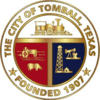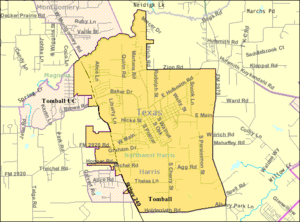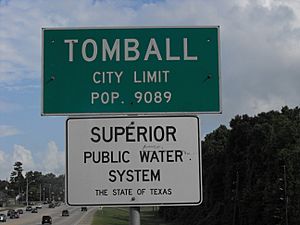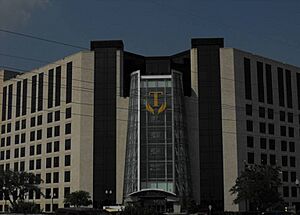Tomball, Texas facts for kids
Quick facts for kids
Tomball, Texas
|
||
|---|---|---|
|
||
| Motto(s):
"Tomball. Texan for Fun!"
|
||
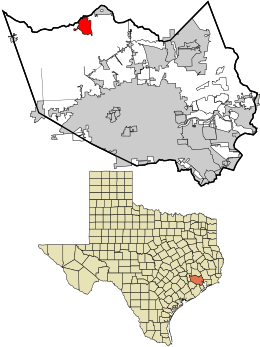
Location in Harris County and the state of Texas
|
||
| Country | ||
| State | ||
| Counties | Harris | |
| City Established | December 2, 1907 | |
| Government | ||
| • Type | Council-Manager | |
| Area | ||
| • Total | 13.09 sq mi (33.91 km2) | |
| • Land | 13.01 sq mi (33.69 km2) | |
| • Water | 0.08 sq mi (0.22 km2) | |
| Elevation | 187 ft (57 m) | |
| Population
(2020)
|
||
| • Total | 12,341 | |
| • Estimate
(2022)
|
13,585 | |
| • Density | 905.51/sq mi (349.62/km2) | |
| Time zone | UTC−6 (Central (CST)) | |
| • Summer (DST) | UTC−5 (CDT) | |
| ZIP codes |
77375, 77377
|
|
| Area code(s) | 281, 346, 713, 832 | |
| FIPS code | 48-73316 | |
| GNIS feature ID | 1348633 | |
| State highways | ||
Tomball (pronounced TOM-bawl) is a city in Harris County, Texas. It is part of the larger Houston metropolitan area, which means it's close to the big city. In 2020, about 12,341 people lived there.
The community was first called Peck. In 1907, it was renamed Tomball. This name honors Thomas Henry Ball, a local politician who helped develop the Port of Houston.
Contents
History
People started settling in the Tomball area in the early 1800s. They found good land for farming and raising cattle. In 1906, the area began to grow quickly. Railroad engineers noticed that Tomball was a perfect spot for a train stop. It was located between the low hills of Texas and the flat coastal plains. This made it easier for trains to carry more cargo downhill towards the Galveston ports.
Thomas Henry Ball, a lawyer for the Trinity and Brazos Valley Railroad, convinced the railroad to build a line right through downtown Tomball. Soon, many people moved to this new train stop. Hotels, boarding houses, and stores quickly appeared. The area was first called Peck, named after a chief engineer of the railroad. But on December 2, 1907, the town was officially named Tom Ball, later shortened to one word: Tomball.
Oil and Gas Discovery
The railroad boom didn't last long, but then the oil and gas industries became important. People thought there might be oil under Tomball, especially after the huge oil discovery at Spindletop in Beaumont. Early searches for oil didn't find anything. But the people of Tomball kept trying.
Their hard work paid off on May 27, 1933. A drill hit a huge gush of oil! People started calling Tomball "a floating island of oil." Soon, many oil companies came to the city. Thousands of workers arrived, and the economy boomed. The Humble Oil Company even made a deal to give free gas to residents. This lasted until 1988, when the oil in the area started to run out.
Tomball officially became a city in 1933. Because of this, the larger city of Houston could not include Tomball's land within its own city limits.
Growth After World War II
Tomball continued to grow, especially after World War II. Many Texans wanted to move from big cities to the countryside. In Tomball, they could avoid high taxes, traffic, and crime. But they were still close to jobs, culture, and fun in the city.
In the 1970s, Tomball's population grew a lot again. Many people moved to the "Sun Belt" region, which offered affordable land, good weather, and job opportunities. Over the next 20 years, Tomball's population in the school district area grew from 16,000 to over 85,000 residents.
Geography
Tomball is located at 30.098905 degrees North and -95.618899 degrees West.
The United States Census Bureau says the city covers about 30.9 square kilometers (11.9 square miles). Most of this area is land, with a small part (about 0.5 square kilometers or 0.2 square miles) being water.
Climate in Tomball
The weather in Tomball has hot, humid summers. Winters are usually mild to cool. Tomball has a humid subtropical climate. This means it gets a lot of rain and has warm temperatures for most of the year.
Population and People
| Historical population | |||
|---|---|---|---|
| Census | Pop. | %± | |
| 1940 | 668 | — | |
| 1950 | 1,065 | 59.4% | |
| 1960 | 1,713 | 60.8% | |
| 1970 | 2,734 | 59.6% | |
| 1980 | 3,996 | 46.2% | |
| 1990 | 6,370 | 59.4% | |
| 2000 | 9,089 | 42.7% | |
| 2010 | 10,753 | 18.3% | |
| 2020 | 12,341 | 14.8% | |
| U.S. Decennial Census | |||
| Race | Number | Percentage |
|---|---|---|
| White (NH) | 8,328 | 67.21% |
| Black or African American (NH) | 833 | 7.13% |
| Native American or Alaska Native (NH) | 27 | 0.22% |
| Asian (NH) | 177 | 1.43% |
| Pacific Islander (NH) | 12 | 0.1% |
| Some Other Race (NH) | 50 | 0.4% |
| Mixed/Multi-Racial (NH) | 430 | 3.47% |
| Hispanic or Latino | 2,484 | 20.05% |
| Total | 12,341 |
In 2020, Tomball had 12,341 people living in 4,516 households. About 2,678 of these were families.
In 2019, the average value of homes owned by residents was $211,700. The average rent was $1,072. About 14.3% of the people in Tomball were living below the poverty line in 2019.
In 2000, there were 9,089 people in the city. About 25.3% of the population was under 18 years old. The average age was 35 years. The median income for a household was $37,787. For families, it was $45,764.
Education
Public Schools in Tomball
Children in Tomball go to schools in the Tomball Independent School District (TISD).
The district has many schools:
- Eleven elementary schools (like Tomball, Decker Prairie, and Wildwood)
- Three intermediate schools (Northpointe, Tomball Intermediate, and Oakcrest Intermediate)
- Four junior high schools (Creekside Park, Tomball, Willow Wood, and Grand Lakes Junior High Schools)
- Three high schools (Tomball High School, Tomball Memorial High School, and Tomball Star Academy)
TISD also has a program called Connections Academy, which includes an 18+ program for older students. In 2019, the Texas Education Agency gave Tomball ISD an "A" rating for its performance.
Private Schools in Tomball
There are several private schools in the Tomball area:
- Concordia Lutheran High School (grades 9-12)
- St. Anne Catholic School (Pre-K to 8th grade), which started in 1984.
- Step by Step Christian School (established 1982)
- Rosehill Christian School (K-12)
- Salem Lutheran School
- Cypress Christian School (K-12), which started in 1978 and now has over 650 students.
- Great Oak School, a Waldorf School (Pre-K to 8th grade)
Colleges and Universities
Lone Star College serves the Tomball community. The area joined the college district in 1982. Students can attend Lone Star College–Tomball, which is part of the Lone Star College System.
Public Libraries
Tomball has a branch of the Harris County Public Library. It is located inside Tomball College and is a shared project between the college and the library system.
Healthcare
Tomball Regional Medical Center is the main hospital serving the city. It is a large hospital with 357 beds. It offers many services, including heart care, cancer treatment, emergency services, and physical therapy. HCA Healthcare Inc. owns this hospital.
Transportation
The city of Tomball is mainly served by two major roads:
- FM 2920 (Main Street), which runs east to west.
- State Highway 249 (Tomball Parkway), which runs north to south.
David Wayne Hooks Memorial Airport is a general aviation airport near Tomball. In 2007, the Texas State Legislature allowed Tomball to include Hooks Airport within its city limits.
Notable People
Many interesting people have connections to Tomball:
- Jake Bates, NFL kicker
- Jenny Adams, track and field athlete
- Jimmy Butler, NBA basketball player
- Ray Collins, former NFL player
- Brooke Daniels, Miss Texas USA 2009
- Mike Eli, singer/songwriter from Eli Young Band
- Clint Fagan, MLB umpire
- Karlie Hay, Miss Teen USA 2016
- Charlie Hayes, former MLB infielder
- Ke'Bryan Hayes, MLB infielder for the Pittsburgh Pirates
- Keith Heinrich, former NFL player
- Chris Herrmann, MLB catcher
- Asher Hong, gymnast
- Justin Jackson, NBA basketball player
- Ben Keating, racing driver and business owner
- Tracy Malechek-Ezekiel
- Venric Mark, former college football player
- Jimmy Needham, contemporary Christian musician
- Chiney Ogwumike, WNBA player for the Los Angeles Sparks
- Nneka Ogwumike, WNBA player for the Seattle Storm and President of the WNBPA
- Troy Patton, MLB pitcher
- David Phelps, Southern Gospel tenor
- Gary Porter, former quarterback and coach
- Debbie Riddle, former member of the Texas House of Representatives
- Dave Smith, former MLB pitcher
- Valoree Swanson, member of the Texas House of Representatives
- Nick Tremark, former MLB outfielder
- Roger Vick, former NFL player
- Sherron Watkins, former executive at Enron
Sister City
Tomball has a sister city relationship with Telgte, Germany. The two cities have programs where students can visit and learn about each other's cultures. Tomball High School also welcomes exchange students from other places, like Armenia.
See also
 In Spanish: Tomball (Texas) para niños
In Spanish: Tomball (Texas) para niños


